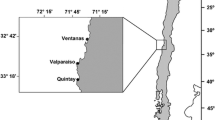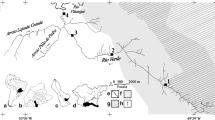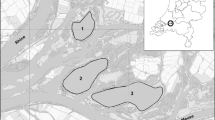Abstract
Flooding mine tailings to limit the oxidation of sulfides provides a habitat for aquatic organisms, such as plants, plankton, insects, and fish, which can uptake metals and, thus, threats for local ecosystems and influence the cycling of elements in biogeocenosis. An aquatic ecosystem developed naturally in sulphide tailing ponds containing cyanidation wastes of the Salair ore-refining plant (SORP), Russia, was studied. The objectives of this research were to: (i) reveal the level of contamination of living organisms in the tailing ponds compared to a natural control site and (ii) calculate the weight of metals in aquatic biomass to estimate the amount of metals transferring from the tailing ponds into the biogechemical cycle. The concentration of Cu, Zn, Cd, and Pb in the sediments of the tailing ponds is significantly higher than from the control site. Concentrations of Cu, Zn, Cd, and Pb in plant shoots were significantly higher than in the control and accumulated mainly in cell envelopes and membranes. The concentration of Pb in fish liver and eggs were 41 and 7.5 times higher, respectively, than maximum allowable concentrations.
The biomass distribution between producers and consumers of the tailing pond ecosystem is similar to those of natural pond ecosystems. However, the weights of Cu, Zn, Cd, and Pb in all trophic levels per hectare of the tailing pond are orders of magnitude higher than those for Lake Baikal. The largest portion of metal circulates within the ecosystem of the Dyukov Ravine Pond with a maximum of 5 to 13% of this amount transferred into the surrounding environment through the food chains.
Similar content being viewed by others
References
V. I. Vernadsky, Assays on Geochemistry, (Nauka, Moscow, 1983).
P. I. Tomakov, V. S. Kovalenko, A. M. Mikhailov, and A. T. Kalashnikov, Ecology and Protection of Surrounding Environment at Open-Cast, (Moscow State University of Mines, Moscow, 1979).
S. P. Golenetsky, T. N. Zhigalovskaya, and S. I. Golenetskaya, “The Impact of Atmospheric Precipitation on Heavy Metal Composition of Soil and Plants,” Pochvovedenie, No. 2, 41–48 (1981).
J. W. Moore and S. Ramamoorty, Heavy Metals in Natural Waters (Mir, Moscow, 1987).
E. I. Khozhina, Extended Abstracts of Candidate’s Dissertation in Geology and Mineralogy (Novosibirsk, 2002).
R. R. Brooks, Biological Methods of Prospecting for Minerals (Wiley, New York, 1983).
A. L. Kovalevsky, Biogeochemistry of Plants (Nauka, Novosibirsk, 1991) [in Russian].
M.J. Wilson, “Acid deposition and heavy metal mobilization,” Appl. Geochem., 11, 133–137 (1996).
V. S. Barsukova, Physiological and Genetic Aspects of Plants Resistivity to Heavy Metals: Analytical Survey (State Public Scientific and Technical Library of SB RAS, Institute of Soil Science and Agrochemistry, Novosibirsk, 1997) [in Russian].
E. I. Hozhina, A. A. Khramov, P. A. Gerasimov, and A. A. Kumarkov, “Uptake of Heavy Metals, Arsenic, and Antimony by Aquatic Plants in the Vicinity of Ore Mining and Processing Industries,” J. Geochem. Explor., 74, 153–162 (2001).
V. A. Alekseenko, Environmental Geochemistry (Logos, Moscow, 2000) [in Russian].
I. Ribet, C. J. Ptacek, D. W. Blowes, and J. L. Jambor, “The Potential for Metal Release by Reductive Dissolution of Weathered Mine Tailings,” J. Contam. Hydrol. 17, 239–273 (1995).
D. K. Nordstrom and C. N. Alpers, “Geochemistry of Acid Mine Water,” in Environmental Geochemistry of Mineral Deposits: Processes, Methods and Health Issues, Ed. by G. S. Plumlee and M. J. Logston, Rev. Econ. Geol., 6A, 133–160 (1999).
S. B. Bortnikova, B. S. Smolyakov, N. V. Sidenko, et al., “Geochemical Consequences of Acid Mine Drainage into a Natural Reservoir: Inorganic Precipitation and Effects on Plankton Activity,” J. Geochem. Explor. 74, 127–139 (2001).
M. Li, A. Aube, and L. St-Arnaud, “Considerations in the Use of Shallow Water Covers for Decommissioning Reactive Tailings,” in Proceedings of the 4th International Conference on Acid Rock Drainage, (Vancouver, BC, 1997) vol. 1, pp. 115–130.
P. H. Simms, E. K. Yanful, L. St-Arnuad, and L. B. Aube, “A Laboratory Evaluation of Metal Release and Transport in Flooded Preoxidized Mine Tailings,” Appl. Geochem. 15, 1245–1263 (2001).
Environment Canada, Threats to Water availability in Canada (NWRI Scientific Assessment Report Series No. 3 and ACSD Science Assessment Series No. 1, National Water Research Institute, Burlington, Ontario, 2004).
World Wildlife Fund (WWF), “The Ecological Effects of Mining spills in the Tisza River System in 2000,” Retrieved April 12, 2006, from http://assets.panda.org/downloads/Tisza_Cyanide_Report.pdf (2002).
G. Veinott, P. Sylvester, D. Hamoutene, et al., “State of the Marine Environment at Little Bay Arm, Newfoundland and Labrador, Canada, 10 years after a “Do-nothing” Response to a Mine Tailings Spill,” J. Environ. Monitor. 5, 626–634 (2003).
D. Kolotov, G. A. Solomin, V. G. Rubeikin, et al., “Hydrogeochemical Processes as the Basis of Interaction between Geological Bodies under the Anthropogenic Influence and Surrounding Environment,” Prikladnaya Geokhimiya, No. 2, 70–98 (2001).
V. M. Katanskaya, Higher Aquatic Plants of Continental Ponds of the USSR (Nauka, Leningrad, 1981) [in Russian].
A. N. Komamitsky, L. V. Kudryashov, and A. A. Uranov, Botany: Plant Taxonomy (Prosvyashenie, Moscow, 1975) [in Russian].
C. A. Stace, Plant Taxonomy and Biosystematics (E. Arnold, a division of Hodder & Stoughton, London, 1989).
P. H. Raven, R. F. Evert, and S. E. Eichhorn, Biology of Plants (W.H. Freeman: Worth Publishers, New York, 1999).
V. G. Hrzhanovsky, Course of General Botany (Nauka, Moscow, 1979) [in Russian].
H. C. Bold, Morphology of Plants (Harper & Row, New York, 1980).
G. N. Gornostaev, Insects of the USSR (Mysl’, Moscow, 1970) [in Russian].
I. J. Holopainen, W. M. Tonn, and C. A. Paszkowski, “Tales of Two Fish: the Dichotomous Biology of Crucian Carp (Carassius Carassius (L.)) in Northern Europe,” Ann. Zool. Fennici 34, 1–22 (1997).
G. V. Nikol’sky, Fish Ecology (Gos. Izd. ‘Vysshaya shkola’, Moscow, 1963) [in Russian].
R. J. Wootton, Fish Ecology (Blackie, Glasgow; Chapman and Hall, New York, 1992).
V. I. Simonova, Atomic Absorption Methods of Elemental Analysis of Rocks and Minerals (Nauka, Novosibirsk, 1986) [in Russian].
G. Keppel, Design and Analysis: A Researcher’s Handbook (Prentice-Hall, Inc., Englewood Cliffs, New Jersey, 1982).
V. M. Katanskaya, “Data for Studying of Biomass Production of Aquatic Plants Growing in Amudarya River,” Trudy laboratorii ozerovedeniya AN SSSR, No. 10, 193–249 (1960a).
V. M. Katanskaya, “Biomass Production of the Vegetation Cover of Several Lakes of Karelian Isthmus,” Trudy laboratorii ozerovedeniya AN SSSR, No. 11, 151–177 (1960b).
I. M. Raspopov, Vegetation Resources of Lake Ladoga: Highest Aquatic Plants of Lake Ladoga (Nauka, Leningrad, 1968) [in Russian].
I. M. Raspopov, Microbiology and Primary Production of Lake Onega: Phytomass and Production of the Macrophytes of Lake Onega (Nauka, Leningrad, 1973) [in Russian].
Solonevich I.G., “Additions to the Method of Determination of Biological Production of Swamp Plant Associations,” Botanichesky Zh., No. 56, 497–511 (1971).
I. D. Golubeva, Lakes of the Middle Volga Region: Flora and Vegetation of the Lakes (Nauka, Leningrad, 1976) [in Russian].
A. I. Obukhov and I. O. Plekhanova, Atomic Absorption Analysis in Soil-Biological Studies (Izd. Moskovskogo universiteta, Moscow, 1991) [in Russian].
S. F. Koval, “Investigation of the Characteristics of Cell Membranes and Plant Steadiness to the Loss of Electrolyte,” Izv. Sib. Otd. Akad. Nauk SSSR, No. 15, 161–168 (1974).
E. I. Khozhina, S. V. Palesskii, and A. I. Saprykin, “Migration of Heavy Metals to the Atmosphere in the Process of Transpiration,” Optika atmosphery okeana, No. 14, 605–608 (2001) [Atmos. Oceanic Opt. 14, 553–556 (2001)].
A. P. Belavsky A.P., “Additions to the method of aquatic plant investigation,” Botanichesky Zh., No. 64, 32–41 (1979).
L. F. Lukina and N. M. Smirnova, Physiology of Higher Aquatic Plants (Naukova dumka, Kiev, 1988) [in Russian].
L. Taiz, Plant Physiology (Sinauer Associates, Sunderland, 1998).
N. V. Sidenko, E. I. Khozhina, and B. L. Sherriff, “The Cycling of Ni, Zn, Cu in the System “Mine Tailings-ground Water-Plants”: A case Study”, Appl. Geochem., in press.
V. A. Vetrov and A. I. Kuznetsova, Microelements in the Natural Habitats of Lake Baikal Region (NITS OIGGM, Izdatelstvo SO RAN, Novosibirsk, 1997).
A. N. Afanasiev, Water Resources and Water Budget of Lake Baikal (Nauka, Novosibirsk, 1982).
A. Beim, E. Grocheva, and A. Renzoni, “Preliminary Results about Contaminants in the Biota of Lake Baikal,” Aquatic Ecosystem Health Management, 3, 245–248 (2000).
V. A. Vetrov, “Lake Baikal Status at the End of XX Century: Environmental Geochemistry,” Ecol. Geochem. 2, 173–195 (2002).
S. B. Bortnikova, A. A. Airiyants A.A., Kolonin G.R., and Lazareva E.V., “Geochemistry and Mineralogy of Technogene Deposits at the Salair Mining and Beneficiation Works,” Geochem. Int. 34, 153–166 (1996).
O. L. Gaskova, S. B. Bortnikova, and A. A. Airiyants, “Behavior of Heavy Metals in the Drainage System of the Salagaevskii Tailings Dump, Town of Salair, Kemerovo Region,” Geochem. Int. 42, 57–66 (2004).
D. Vaughan and B. G. Ord, “Soil Organic Matter: a Perspective on its Nature, Extraction, Turnover and Role in Soil Fertility,” in Soil Organic Matter and Biological Activity, Ed. by D. Vaughan and R. E. Malcolm (Martinus Nijhoff, Dr W. Junk Publishers, Dordrecht, 1985), pp. 1–35 (1985).
S. Bernatowicz, S. Leszczynski, and S. Tyczynska, “The Influence of Transpirations by Emergent Plants on the Water Balance in Lakes,” Aquatic Botany, No. 2, 275–288 (1976).
List of MACs and Nontoxic Levels of Contaminant Exposure for Pond Water of Fish Farms (TOO “Medinor”, Moscow, 1995).
Author information
Authors and Affiliations
Corresponding author
Rights and permissions
About this article
Cite this article
Khozhina, E.I., Sherriff, B.L. The accumulation of Cu, Zn, Cd, and Pb in the aquatic biomass of sulphide tailing ponds. Geochem. Int. 46, 897–911 (2008). https://doi.org/10.1134/S0016702908090048
Published:
Issue Date:
DOI: https://doi.org/10.1134/S0016702908090048




